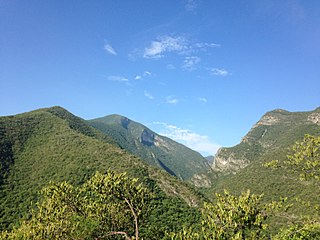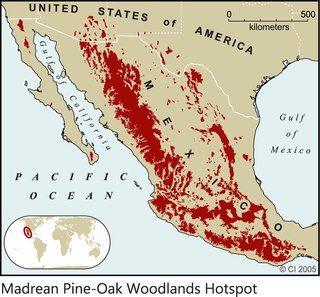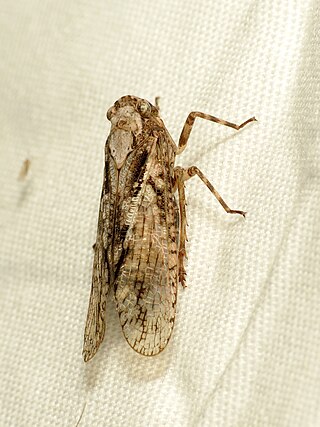
The Sierra Madre Oriental is a mountain range in northeastern Mexico. The Sierra Madre Oriental is part of the American Cordillera, a chain of mountain ranges (cordillera) that consists of an almost continuous sequence of mountain ranges that form the western "backbone" of North America, Central America, South America, and Antarctica.

The Madrean pine–oak woodlands are subtropical woodlands found in the mountains of Mexico and the southwestern United States. They are a biogeographic region of the tropical and subtropical coniferous forests and temperate broadleaf and mixed forests biomes, located in North America.

The Sierra Madre Occidental pine–oak forests are a Temperate broadleaf and mixed forests ecoregion of the Sierra Madre Occidental range from the southwest USA region to the western part of Mexico. They are home to a large number of endemic plants and important habitat for wildlife.

Quercus polymorpha, the Mexican white oak, Monterrey oak or netleaf white oak, is a North American species of oak. It is widespread in Mexico, Guatemala, and Honduras, and known from a single population in the United States but widely planted as an ornamental.
Sparganothoides arcuatana is a species of moth of the family Tortricidae. It is found in southern Mexico, where it is known from the Sierra Madre Occidental in Jalisco and the Sierra Madre Oriental in Veracruz and Puebla, ranging south to Oaxaca. The habitat consists of montane areas.

Quercus tarahumara is a species of tree in the beech family. It grows in the Sierra Madre Occidental in the Mexican States of Chihuahua, Sonora, Durango, and Sinaloa. Some of the populations lie within the territory occupied by the Tarahumara people, after whom the species is named. It is placed in Quercus section Lobatae.

Quercus castanea is a species of oak tree. It is widespread across much of Mexico, from Sonora to Chiapas, and in Guatemala, El Salvador, and Honduras.

Quercus elliptica is a Mesoamerican species of oak tree. It is widespread across central and southern Mexico and Central America from Sinaloa and Hidalgo south as far as Nicaragua. It is classified in Quercus sect. Lobatae.

Calyptoproctus is a genus of planthoppers in the family Fulgoridae; records are from Central and South America.

Pintalia is a genus of cixiid planthoppers in the family Cixiidae. There are at least 50 described species in Pintalia.
Neofidia humeralis is a species of leaf beetle. It ranges from southeastern Arizona and southwestern New Mexico, along the Sierra Madre Occidental and Sierra Madre del Sur, south to Oaxaca in southwestern Mexico. It was first described as two species, Fidia humeralis and Fidia plagiata, by the French entomologist Édouard Lefèvre in 1877. These two species were later found to be synonymous.

The subfamily Poiocerinae include Hemipteran insects in the family Fulgoridae, found especially in the tropics.

The Cuenca Alimentadora del Distrito Nacional de Riego 043 Estado de Nayarit is a protected natural area in west-central Mexico. It extends across portions of southern Sierra Madre Occidental and the westernmost Trans-Mexican Volcanic Belt. It has an area of 23290.27 km2, covering portions of southern Durango, northern Jalisco, eastern Nayarit, southern Zacatecas, and western Aguascalientes states.
Alphina is a genus of planthoppers in the family Fulgoridae occurring in South America.

Scaralina is a genus of planthoppers in the family Fulgoridae occurring in North America and Central America, from Idaho to Panama.

Scaralis is a genus of planthoppers in the family Fulgoridae occurring in Central America and South America. The genus contains 13 species, placed into two subgenera.
Scaralina cristata is a species of planthopper in the family Fulgoridae. It is found from Arizona in the United States south to the Sierra Madre Occidental in Mexico. It is one of four species that were, for several decades, erroneously grouped together under a single name, Alphina glauca; this name is now treated as a synonym of S. marmorata.
Scaralina metcalfi is a species of planthopper in the family Fulgoridae. It is found from Arizona in the United States south to the Sierra Madre Occidental in Mexico. It is one of four species that were, for several decades, erroneously grouped together under a single name, Alphina glauca; this name is now treated as a synonym of S. marmorata.
Scaralina marmorata is a species of planthopper in the family Fulgoridae, found throughout the southeastern United States. It is one of four species that were, for several decades, erroneously grouped together under a single name, Alphina glauca; this name is now treated as a synonym of S. marmorata.
Scaralis inbio is a species of lanternfly from Guatemala and Costa Rica. It is placed in a new subgenus Alphinoides.













